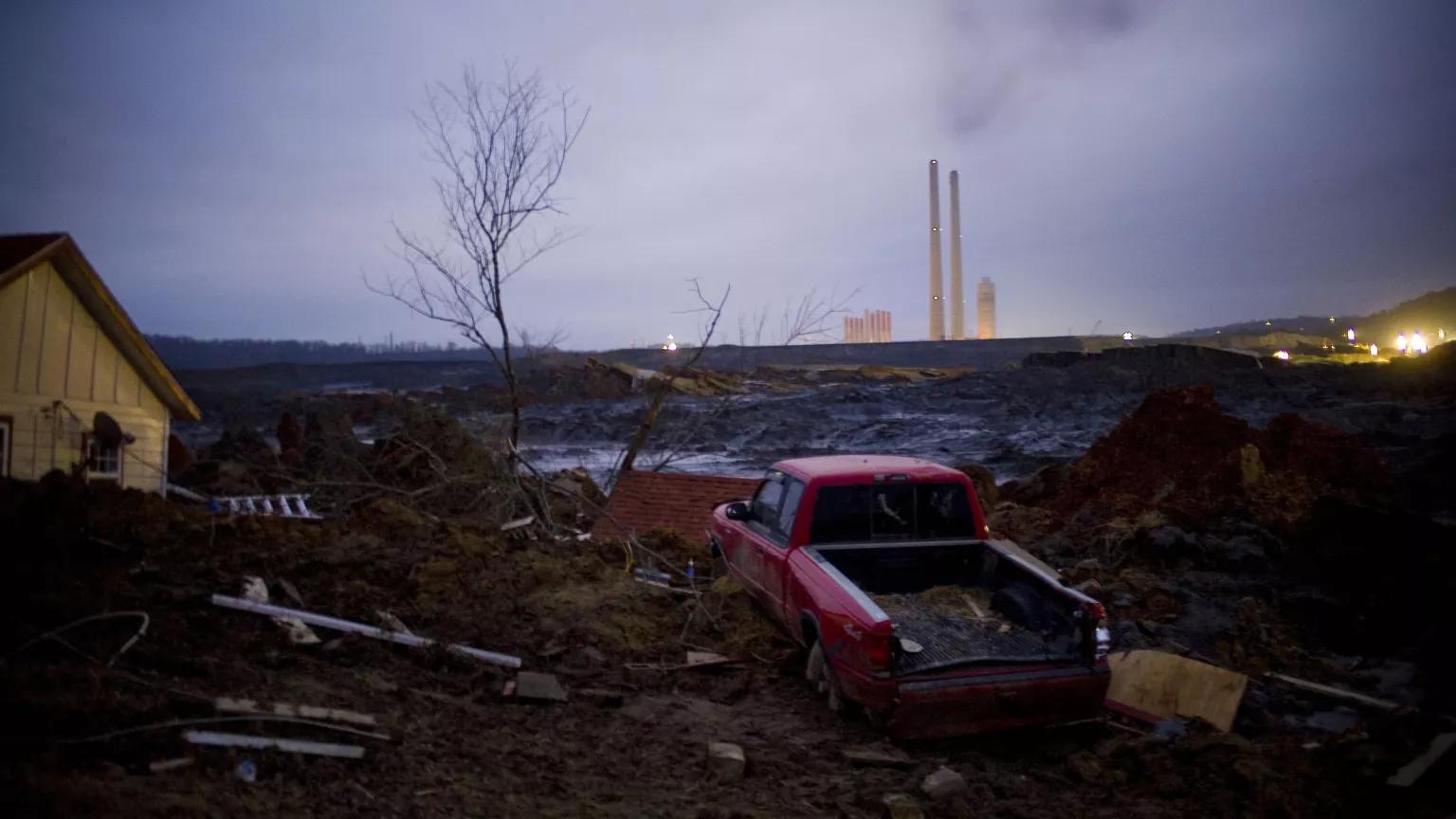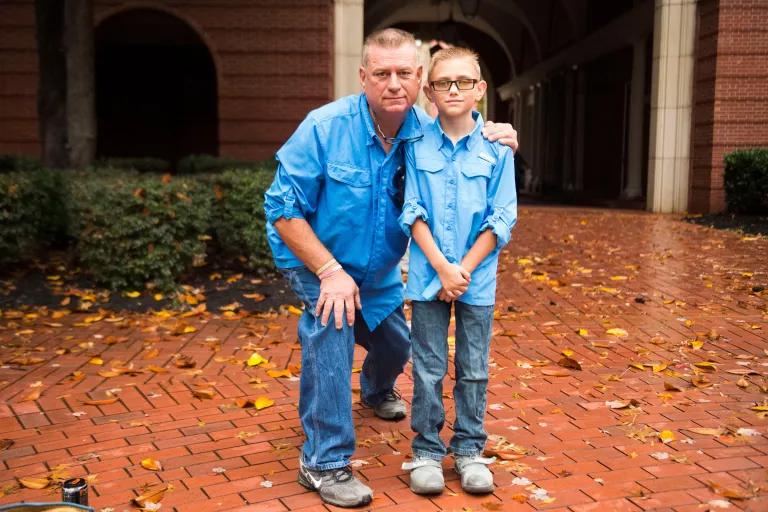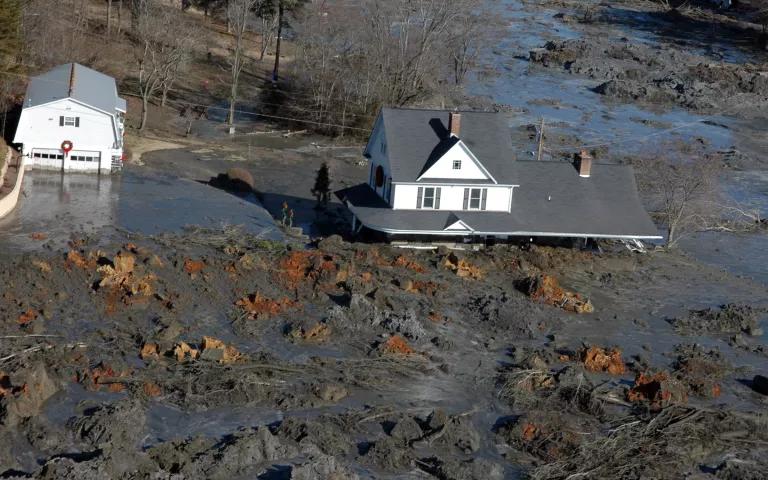Hundreds of Workers Who Cleaned Up the Country’s Worst Coal Ash Spill Are Now Sick and Dying
Ten years after the disaster at a Tennessee power plant, the cleanup crew is seeking justice. At the same time, the Trump administration is weakening protections for this toxic pollution.

The devastated landscape near Harriman, Tennessee, after coal ash from TVA’s Kingston fossil plant flooded the town
Noah Rabinowitz/Aurora Photos/Alamy Stock Photo
Michael McCarthy had a new job, a baby at home, and another on the way. At age 45, he was, by his estimation, “fit as a fiddle.” Then, three days before Christmas 2008, more than 1.5 million tons of coal ash, a byproduct of coal combustion, broke out of a Tennessee power plant, pouring into the Emory and Clinch rivers and covering 300 acres, including the small community of Swan Pond, with a thick gray sludge. The muck, which contained toxic substances such as arsenic, lead, mercury, and radium, flooded about two dozen houses. McCarthy’s home was not one of them, but he was part of the crew handling the cleanup, an effort that lasted years.
“I used to come home with the ash on me—on my clothes, in my hair, my ears, up my nose, my throat, on my boots, everywhere,” says McCarthy. “I came home and took care of my babies. I played with them and held them while I was contaminated.”
Three months after the spill, McCarthy’s wife, Tina, became pregnant with their son, Jimmy. For the next five years Tina shook out her husband’s clothes on the porch, washed them with the family laundry, and swept the rest of the ash from the house.
A decade later, the McCarthys are sick. According to a civil lawsuit against McCarthy’s former employer, Jacobs Engineering, LLC, they are suffering ailments linked to coal ash exposure. McCarthy has undergone three heart surgeries since 2012 and is plagued by breathing problems and chest pains. He also reports low testosterone levels, a condition that saps his energy and lowers his sex drive.

Kingston coal ash spill worker Mike McCarthy and his son Jimmy at the U.S. District Court in Knoxville
Caitie McMekin/Knoxville News Sentinel
But McCarthy worries more about his kids. A 2018 study found children and pregnant women are more vulnerable to the effects of coal ash, which include birth defects, developmental delays, various types of cancer, and damage to the heart, lungs, and nervous system. According to a report from Physicians for Social Responsibility, “coal ash toxins have the potential to injure all of the major organ systems.” In addition to needing her gallbladder removed, Tina, who ended up delivering Jimmy prematurely, has suffered various ailments over the years. In 2011, McCarthy’s daughter, Angie, required an emergency blood transfusion for critically low iron levels. Jimmy needs a nebulizer, a machine that delivers medication in a fine mist, to open his lungs and help him breathe, sometimes weekly, sometimes daily, depending on his activity level. “The big attacks come at night when we’re sleeping,” says McCarthy. “Jimmy will come in and wake me up with his little voice and say, ‘I can’t breathe.’”
And the McCarthys are not alone. Hundreds of cleanup workers have been sickened, and dozens have died.
Disasters Waiting to Happen
The McCarthys represent an ever-growing number of Americans who are suffering the consequences of the improper storage of coal ash. The United States produces more than 130 million tons of the stuff each year, kept in more than 1,100 sites across the country. Utilities often wet the ash and contain it within unlined ponds, a practice that a 2016 Duke University study found to contaminate surface water and groundwater with high levels of arsenic and selenium at 21 power plants in five southeastern states.
In September, Hurricane Florence caused about 1,000 tons, or about 150 truckloads, to spill from a Duke Energy site in North Carolina, contaminating a lake and the Cape Fear River. Another, much bigger Duke Energy spill of nearly 40,000 tons sullied the Dan River in 2014. That disaster prompted the U.S. Environmental Protection Agency to pass the 2015 Coal Ash Rule, which took some crucial first steps to making its disposal safer, such as closing any ash ponds leaking into groundwater and making liners mandatory for new ponds. But some of those small gains were rolled back earlier this year by the Trump administration.
In October, a coalition of environmental groups, including Earthjustice and the Sierra Club, challenged the weakening of the Coal Ash Rule in a petition to the U.S. Court of Appeals, saying the move was a “direct threat to public health and safety.” The EPA claims it could save $28 million to $31 million in annual regulatory expenses, but it is failing to consider the price tags of such a rollback: The costly cleanups. The chronic contamination of land and water supplies. The burdens these disasters place on the health of Americans.
Eating Ash
The spill affecting the McCarthys occurred after an unlined containment pond failed at the Tennessee Valley Authority’s (TVA) Kingston coal plant, creating the nation’s biggest coal ash spill. The TVA paid Jacobs Engineering $64 million to clean it up. According to Jacobs employees, including McCarthy, they were covered in ash daily, wearing ordinary gear, and lacking adequate safety equipment.
The repercussions have been severe. Of the 900 cleanup workers, more than 30 have died. Another 200 workers are sick or dying. Many of the ill, including McCarthy, spent three weeks in court this fall testifying against Jacobs for failing to protect them from the fly ash, a light form of coal ash that floats into the plant’s exhaust stacks.
Jacobs, a Texas-based company with more than 230 locations worldwide, has a long history with worker-safety lawsuits and settlements. The company, for instance, was recently banned from bidding on jobs in Hong Kong for a year, and 21 of its employees were arrested for forged safety tests of concrete intended for a six-mile stretch of bridge near Hong Kong. Back in Tennessee, Jacobs provided its employees working in the “exclusion zone,” the most dangerous section, with a single wash pan to help clean off their boots. The Knoxville News Sentinel described the pan as “the size of a cat’s litter box.”
“We were told constantly throughout the years that it was safe. That you can eat it and drink it and it won’t hurt you,” says McCarthy before entering into a fit of coughing, one of several such interruptions during our short telephone call. “Needless to say, I can’t breathe anymore.”
In a video McCarthy secretly shot on the job site, his supervisor, Chris Eich, tells McCarthy that pollen, not coal ash, is causing his sinus infections, nosebleeds, and coughing fits. Eich tells McCarthy to take Allegra and vulgarly dismisses his concerns about wearing a respiratory device.
Dust masks had been initially available at the site until Jacobs’ safety manager, Tom Bock, ordered their removal. The reason is unclear, but workers theorize he didn’t want the public to think the site was unsafe. According to the Knoxville News Sentinel, Bock also ended the workers’ daily tests for chemical exposure and limited the weekly tests to cover only silica, one of the lesser toxic substances found in coal ash. Yet even after all that, documents show he still tampered with the results.

An engulfed home near TVA’s Kingston fossil plant
J. Miles Cary/Knoxville News Sentinel via, Associate Press
Bock also told his crew they could literally eat coal ash, a claim that originated in an email from Bock’s then-boss Sean Healey, who wrote that workers would “have to ingest about one pound of fly ash per day just to get to the allowable arsenic body burden.”
The managers at Jacobs weren’t the only ones downplaying the dangers of coal ash. In a 60 Minutes interview in 2009, TVA spokesperson Anda Ray told Lesley Stahl she would be willing to swim in the ash-contaminated Emory River (something she later retracted after remembering the government advisory against it). For its part, the EPA, which was in charge of the cleanup plan, did not enforce its own safety standards for coal ash exposure, according to records obtained by USA Today–Tennessee. And neither TVA nor the EPA told workers about the independent tests done by Tetra Tech, Wake Forest University, and Duke University, which all found dangerous levels of arsenic and radium at the spill site.
The Jury Is In
A federal jury in Knoxville ruled in early November that Jacobs Engineering had endangered the health of its workers. Since they’ve gotten sick, McCarthy and his coworkers have been paying skyrocketing medical expenses out of their own pockets, and the next phase of the lawsuit, beginning in early 2019, will seek damages to pay for medical testing and treatment of themselves and their families.
Lead attorney Jim Scott, who has worked to bring this case to trial since 2013, says there are more workers, family members of workers, and community members who lived close to the spill who are suffering similar illnesses and conditions. “I don’t have any idea how long the process will take,” says Scott, “but I can tell you we will be pursuing it rapidly and aggressively. These people’s families need help.”
This NRDC.org story is available for online republication by news media outlets or nonprofits under these conditions: The writer(s) must be credited with a byline; you must note prominently that the story was originally published by NRDC.org and link to the original; the story cannot be edited (beyond simple things such as grammar); you can’t resell the story in any form or grant republishing rights to other outlets; you can’t republish our material wholesale or automatically—you need to select stories individually; you can’t republish the photos or graphics on our site without specific permission; you should drop us a note to let us know when you’ve used one of our stories.

Mercury’s Journey from Coal-Burning Power Plants to Your Plate
Communities to Coal Plants: Clean Up Your Mess Before You Go!
Environmental Justice in Chicago: It’s Been One Battle After Another